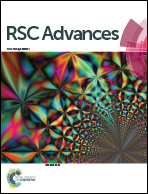A study on mediating the crystallization behavior of PBT through intermolecular hydrogen-bonding
Abstract
Intermolecular hydrogen-bonding could be formed between poly(butylene terephthalate) (PBT) and 4,4′-thiodiphenol (TDP) which was verified using advanced quantum-chemistry calculations. Blends of PBT and TDP were prepared through melt blending and the intermolecular hydrogen-bonding was characterized using Fourier transform infrared spectroscopy (FTIR). The results showed that intermolecular hydrogen-bonding formed between the carbonyl group of PBT and hydroxyl group of TDP, the carbonyl and hydroxyl absorption bands shifted to a lower wavenumber and the shape of the hydroxyl peaks became wider asymmetrically with increasing TDP content. The effects of hydrogen bonding on the crystallization and melting behaviors of PBT were investigated using differential scanning calorimetry (DSC), polarized optical microscopy (POM) and wide angle X-ray diffraction (WAXD). The results showed that both the non-isothermal melt-crystallization behavior and isothermal crystallization kinetics of PBT were inhibited by the addition of TDP. The overall isothermal crystallization rates of PBT in the PBT/TDP blends were obviously slower than that of pure PBT at the same crystallization temperature. The crystal structure of PBT did not change through the incorporation of TDP, while the crystallinity and the crystal size of PBT decreased with increasing TDP content.


 Please wait while we load your content...
Please wait while we load your content...